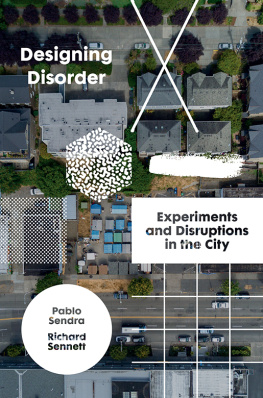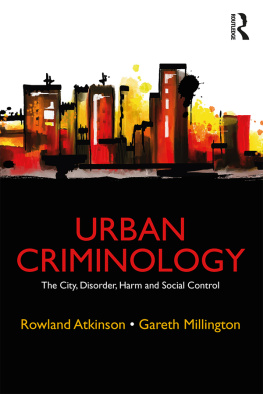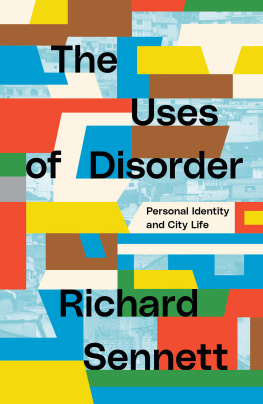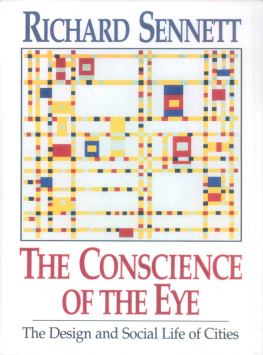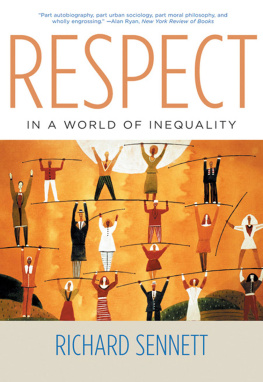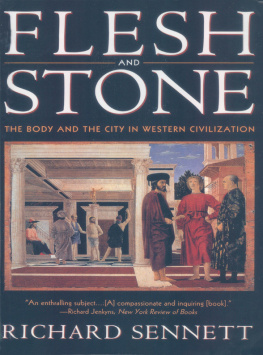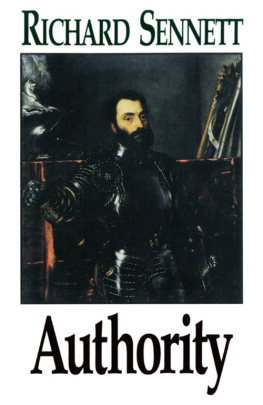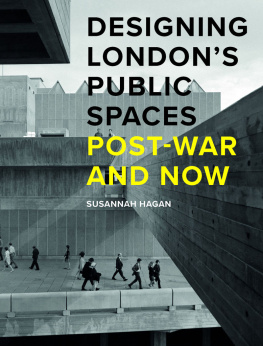Contents
This eBook is licensed to Angel Sison, doroteojosestation@gmail.com on 04/16/2020
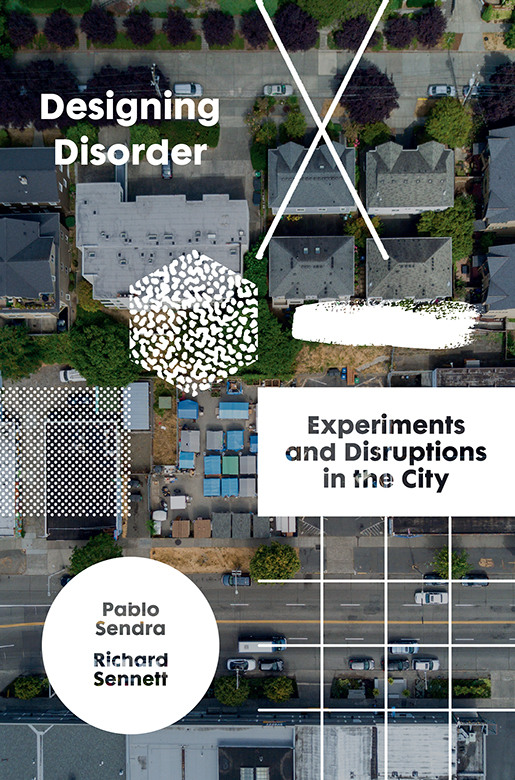
Designing Disorder
This eBook is licensed to Angel Sison, doroteojosestation@gmail.com on 04/16/2020
Designing Disorder
Experiments and
Disruptions in the City
Pablo Sendra
and
Richard Sennett

This eBook is licensed to Angel Sison, doroteojosestation@gmail.com on 04/16/2020
First published by Verso 2020
Pablo Sendra and Richard Sennett 2020
All rights reserved
The moral rights of the authors have been asserted
1 3 5 7 9 10 8 6 4 2
Verso
UK: 6 Meard Street, London W1F 0EG
US: 20 Jay Street, Suite 1010, Brooklyn, NY 11201
versobooks.com
Verso is the imprint of New Left Books
ISBN-13: 978-1-78873-780-7
ISBN-13: 978-1-78873-781-4 (UK EBK)
ISBN-13: 978-1-78873-782-1 (US EBK)
British Library Cataloguing in Publication Data
A catalogue record for this book is available from the British Library
Library of Congress Cataloging-in-Publication Data
Names: Sendra, Pablo, author. | Sennett, Richard, 1943- author. | Hollis, Leo, interviewer.
Title: Designing disorder : experiments and disruptions in the city / Pablo Sendra and Richard Sennett.
Description: London ; New York : Verso, 2020. | Includes index. | Summary:
In 1970, Richard Sennett published the groundbreaking The Uses of Disorder, arguing that the ideal of a planned and ordered city was flawed. Fifty years later, Sennett returns to these still fertile ideas and, alongside campaigner and architect Pablo Sendra, sets out an agenda for the design and ethics of the Open City. The public spaces of our cities are under siege from planners, privatisation and increased surveillance. Our streets are becoming ever more lifeless and ordered. What is to be done? Can disorder be designed? In this provocative essay Sendra and Sennett propose a reorganisation of how we think and plan the social life of our cities. Infrastructures of disorder combine architecture, politics, urban planning and activism in order to develop places that nurture rather than stifle, bring together rather than divide up, remain open to change rather than closed off Provided by publisher.
Identifiers: LCCN 2019052099 (print) | LCCN 2019052100 (ebook) | ISBN 9781788737807 (hardcover) | ISBN 9781788737821 (ebook)
Subjects: LCSH: Public spacesSocial aspects. | City planningSocial aspects. | City and town life.
Classification: LCC HT185 .S55 2020 (print) | LCC HT185 (ebook) | DDC 307.1/216dc23
LC record available at https://lccn.loc.gov/2019052099
LC ebook record available at https://lccn.loc.gov/2019052100
Typeset in Sabon by MJ & N Gavan, Truro, Cornwall
Printed and bound by CPI Group (UK) Ltd, Croydon CR0 4YY
This eBook is licensed to Angel Sison, doroteojosestation@gmail.com on 04/16/2020
Contents
This eBook is licensed to Angel Sison, doroteojosestation@gmail.com on 04/16/2020
Pablo Sendra and Richard Sennett
Rigid, overdetermined forms are smothering the modern city. These unyielding environments suppress peoples freedom to act, stifle informal social relations, and inhibit the citys power to grow. In this book, we propose an alternative, underdetermined form of city-making, one which disrupts rigid forms, putting in their place more life-enhancing designs.
Evidence of overdetermined form now dominates Manhattans skyline. Located at the north end of the High Line, Hudson Yards represents the commercially driven urbanism that has transformed cities like New York and London. Hudson Yards is an assemblage of luxury condominiums and rentals, a hotel, offices, restaurants and a shopping mall offering the most expensive brands. In its centre is the Vessel, a sculptural staircase designed less for use than as a picture frame for commercial promotions. The square is delimited in its south part by the Shed, a gigantic movable structure that aims to become a flexible arts venue for big-ticket performances. This enormous development neither encourages local activities by ordinary citizens, nor can its fixed forms evolve; it can only degrade.
In contrast, Hudson Yards is bordered on its east side by the Garment District, a vibrant, diverse community with small as well as large businesses, mixing relatively recent Korean immigrants with other established immigrant communities, combining housing for working- and middle-class people with schools and churches. This complex, often noisy and unruly community has been able to evolve and prosper over the last century and a half.
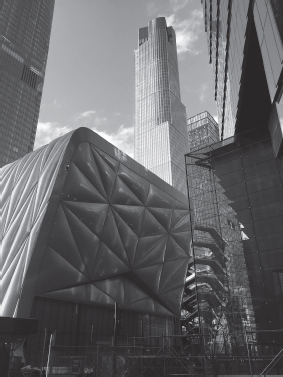
Figure 1: Global capital imposing order. Hudson Yards, New York City. In the image: the shopping mall (right), the Shed (left), the Vessel (centre-back) and the skyscrapers. March 2019.
In this book we want to show how such a community can be designed that is, what kind of basic forms, what kind of urban DNA, allows a place to grow.
This book builds on the work of one of the authors, Richard Sennett. In 1970, when The Uses of Disorder was published, the reasons Richard saw behind the overlap of so many different kinds of life If The Uses of Disorder saw modernist developments as impositions of order that were erasing city life, today the forms of order imposed come from a globalised real estate industry.
A vital and open city does not occur naturally. There are places where improvised activities and social interaction do not happen because the rigidity of the urban environment does not allow this improvisation to take place, and planning for disorder is necessary. When architect Pablo Sendra read The Uses of Disorder, he decided to explore which urban design interventions could enable the kinds of disorder that allow for unplanned activities and provide an open-ended urban configuration that can change according to peoples actions. This book proposes urban design experiments for those places where spontaneous activities and social interactions do not occur. It does not propose design strategies for places where informality and sociability are already happening, but it rather explores disruptions in urban design that can dismantle overly rigid environments.
This collaboration between architect Pablo Sendra and sociologist Richard Sennett revisits The Uses of Disorder ideas of a disordered, unstable, direct social lifeordered urban environments, encourage the unplanned use of public space and provoke social interaction. Pablos piece is not a prescriptive manual; rather, it encompasses suggestions for how design can become more open-ended in scope and more collective in practice. The third part of the book is a discussion between Pablo Sendra and Richard Sennett, moderated by editor Leo Hollis, in which they reflect on the implications of The Uses of Disorder today.
This eBook is licensed to Angel Sison, doroteojosestation@gmail.com on 04/16/2020
Richard Sennett
This eBook is licensed to Angel Sison, doroteojosestation@gmail.com on 04/16/2020
In 1804, midway through the military conquest of Europe, Napoleon laid out laws to regulate civil society in France and throughout his empire. The code civil imposed order on everyday life by regulating family affairs, defining school curricula and organising religious practices. This was the first great piece of modern social engineering.

